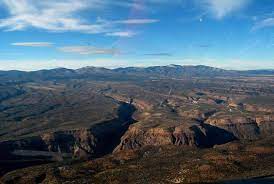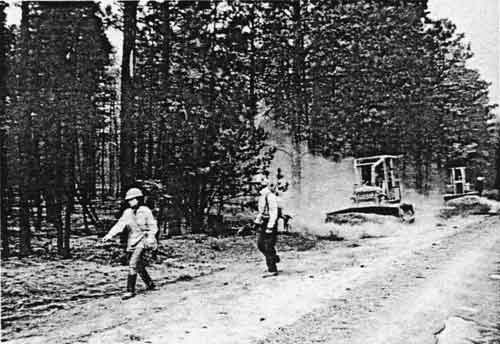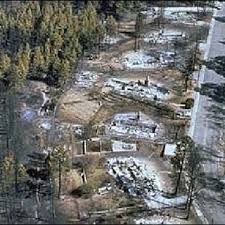
On the Parjarito Plateau, a volcanic plateau in the Jemez Mountains of north central New Mexico, large fires used to occur about every twenty years, following a natural climate cycle. Years of heavy rains and deep snows would lead to luxuriant growth of new trees and undergrowth, which would become natural fuel during drought years. Lately, the frequency and intensity of fires has increased, and so have their damage. Some of these fires have begun naturally, most frequently from lightning strikes. Others have been started by irresponsible people who've thrown a cigarette butt out the window of a moving car or left a campfire smoldering. The latest and most destructive have begun as controlled burns that overstepped their bounds. Here are some of the most notable of the past eighty years.
The first time a fire led to the evacuation of Los Alamos laboratories was in 1954. The Water Canyon Fire began as a trash and construction debris burn on June 5, 1954. High winds, including gusts up to 45 mph pushed the fire north. It burned out of control for several days before 1,000 firefighters and a drop in wind speed slowed it down. Between 3,000 and 6,000 acres of forest were lost.
 Archaeologists walk in front of bulldozers in an attempt to preserve and protect indigenous and early sites during the La Mesa fire.
Archaeologists walk in front of bulldozers in an attempt to preserve and protect indigenous and early sites during the La Mesa fire.On June 16 1977, the La Mesa fire began. It took a week and over 1,300 personnel to contain the fire that investigators believe began with a spark from a motorcycle. The fire reached K-site and S-site, two facilities in Los Alamos National Laboratory used to fabricate and test chemical explosives, and burned 15,444 acres of Bandelier National Monument. Approximately 60% of the drainage basin of Rio de Los Frijoles, a tributary of the Rio Grande, was burned, leading to severe erosion when the monsoons began later that summer.
 The Dome Fire, seen from Los Alamos
The Dome Fire, seen from Los AlamosIn 1996, the Dome Fire began on April 26, when two campers left a campfire burning. By the time it was controlled, it had burned over 16,500 acres and threatened the southern section of Los Alamos National Laboratory. Large areas of Capulin Canyon and the Dome Wilderness were charred. The fire sent flames hundreds of feet into the air and developed a spectacular plume that could be seen for miles. Over 800 firefighters fought this blaze.

Two years after that, the Cerro Grande Fire began in May 2000 as a controlled burn that was supposed to reduce fire danger in Bandelier National Monument. High winds and dry conditions led the fire to jump its bounds. The fire destroyed over 400 homes in Los Alamos and damaged or destroyed several structures at Los Alamos National Laboratory. Over 43,000-acres were charred.

Two years later, the Oso Complex Fire was intentionally started by a man as a protest against government officials whom he claimed were using environmental laws to displace the poor, Hispanic population. Begun on June 20, 1998, the fire burned 5,185 acres of National Forest, including over 1,200 acres owned by Santa Clara Pueblo. It came within 8 miles of Los Alamos before rains and over 800 fire fighters, many of whom were Native Americans, were able to stop it. The arsonist pled guilty and was given a seven-year sentence in federal prison.

When it happened in 2011, the Las Conchas Fire was the largest wildfire the state of New Mexico had ever seen. It began on June 26, 2011 when an old, dead aspen tree blew into a power line. Driven by strong and unpredictable winds, the fire burned more than 150,000 acres of Pajarito Plateau and threatened the Pajarito Mountain Ski Area, the town of Cochiti, Los Alamos, and Santa Clara Pueblo. It was surpassed in 2012 by the much larger Whitewater-Baldy Complex Fire and in 2022 by the Calf Canyon/Hermits Peak Fire and the Black Fire.
The 2022 Calf Canyon/Hermits Peak Fire burned 341,471 acres and blazed from early April to late June. This fire, was in the southern Sangre de Cristo Mountains, and not on Parjarito Plateau. Part of the record-breaking 2022 wildfire season, it was the largest wildfire of 2022 in the contiguous United States and destroyed or damaged nearly a thousand structures, including several hundred homes. The fire began as two separate wildfires, both of which were U.S. Forest Service prescribed burns. It was not fully contained until August 21.
However they are started, wildfires in New Mexico cause terrible damage and stress to its residents, who live in fear both for their property and their lives. As climate change dries out the forests, we must all be even more vigilant.

Jennifer Bohnhoff is a former English and history teacher who lives in a remote spot in the mountains of central New Mexico.The local fire department has told her that her own house is unlikely to be saved in a wildfire.
Her next novel, Summer of the Bombers, will be released in April 2023. Set in the fictitious town of Alamitos, it tells the story of a young woman whose life becomes chaotic after a controlled burn goes rogue and destroys her house. It is based loosely on the Cerro Grande fire of 2000.
You can read more about her and her books here.
Her next novel, Summer of the Bombers, will be released in April 2023. Set in the fictitious town of Alamitos, it tells the story of a young woman whose life becomes chaotic after a controlled burn goes rogue and destroys her house. It is based loosely on the Cerro Grande fire of 2000.
You can read more about her and her books here.






No comments:
Post a Comment